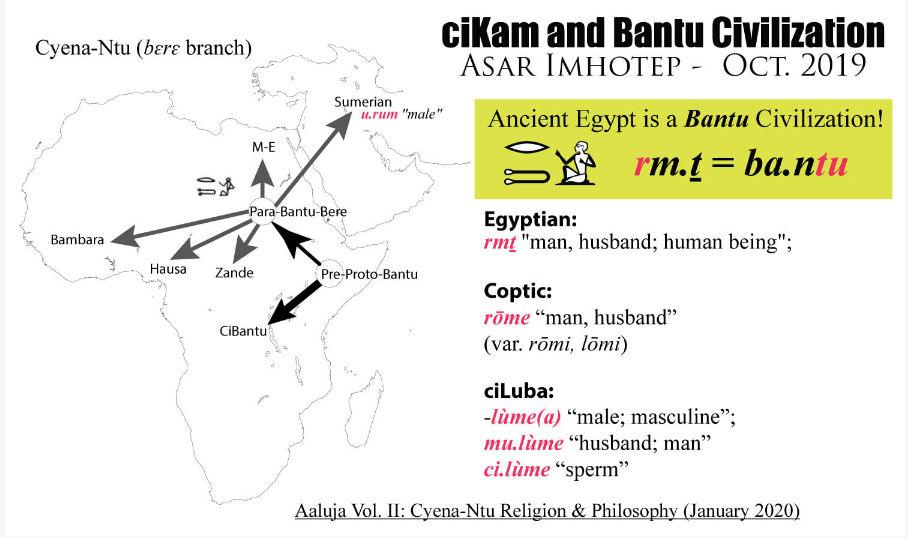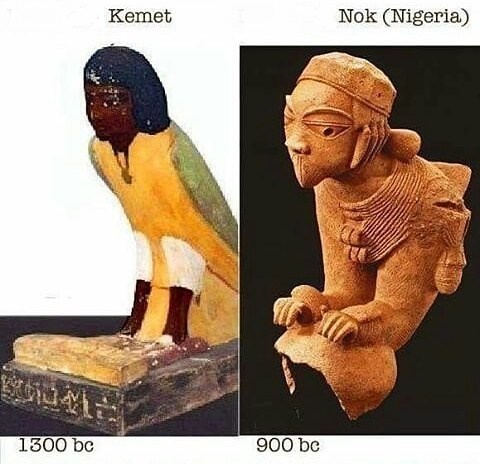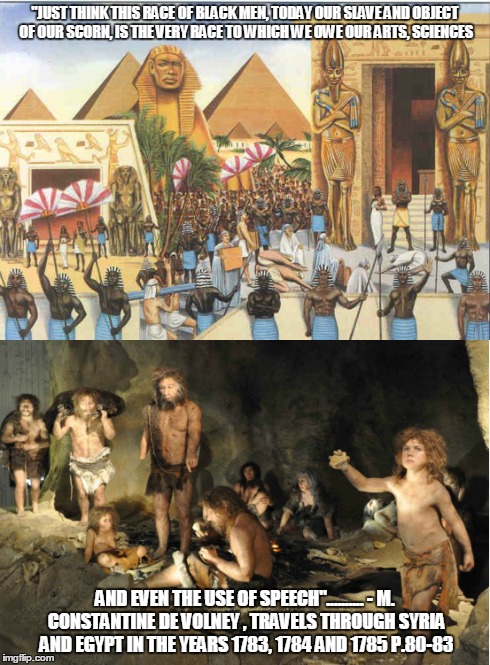Incorrect. Asar Imhotep has done a great job at narrating a new concrete foundation for African linguistics, and particularly Bantu. Bantu was clearly spoken in ancient Sumer as shown in his examples below.
"ABOUT THE AUTHOR: GJK Campbell-Dunn (frm Sumerian Grammar 2009)
Graham Campbell-Dunn was awarded his MA in Classics with First Class Honours by the University of New Zealand and went to Cambridge on a Postgraduate Scholarship, where he studied under the comparativists W. S. Allen and R. G. Coleman. His eminent teachers also included John Chadwick who worked on the Linear B decipherment and the linguist John Lyons, a former student of Noam Chomsky.
After lecturing at the NZ universities Graham retired in 1991 to devote his time to research into the African origins of the classical and related languages. His interest in Italian theories of Mediterranean substrate lead him to study the work of the Niger-Congo comparative scholars D. Westermann and H. Mukarovsky. His researches have cast new light on Minoan Linear A, Etruscan, Basque, Indo-European and now Sumerian. Graham is the founder of Template Theory, a radical new hypothesis concerning syllabic structure and lost sound replacement in early African languages.
This book applies the comparative method to prove that Sumerian is not a language isolate. It is related in its vocabulary, grammar and phonology to the Niger-Congo group of languages. The relationship is particularly close for languages of the Mande group, with which it shares OV word order and erosion of the original Niger-Congo noun prefixes. Niger-Congo suffixes can also be identified, such as the postposed article in –la, -a, -al and the old Niger-Congo definite in –ri, -di.
SUMERIAN.....NIGER-CONGO.....MEANING
ni, nitah “man”.....ni.....“man”
eme “tongue”.....(d)eme.....“tongue”
lu “male”.....lu.....“head”, “chief”
ĝin “to go”.....gi.....“go”
ki “earth”.....cí.....“earth”
aba “who ?”.....(a)-ba.....“someone”
bi “speak”.....bil.....“tell”
pa “wing”.....papa.....“wing”
da “side”.....tá.....“thigh”
tir “forest”.....ti.....“tree”
kár “encircle”.....ka.....“ring”
me6 “to make”.....ma.....“to make”
mu “to burn”.....mudi.....“torch, bright”
hul “destroy”.....kú,kúá.....“kill”
a-rà “road’.....njila.....“road”
ĝír “sword”, si “horn”.....kin “needle”, & cín.....“horn”
zú “tooth”.....dum.....“to bite”
The Sumerian silent determinatives (really classifiers), about 55 of which are used with certain nouns, have all now been assigned Niger-Congo etymologies. Thus uru, iri “det. with towns” is Niger-Congo lu, li, (ru, ri) “head” (compare English “capital”), with a Niger-Congo vocalic prefix before the root. Likewise ki “det. with places” is Niger-Congo gi,, ki, kyi, ci “village, settlement”. Even sik, siki “det. for wool etc” is a Niger-Congo word for “hair, fur” applied to wool. The clarification of this large grammatical system clinches the argument, and sheds new light on the early structure of Niger-Congo and Nilo-Saharan languages.
::::::::::::::::::::::::::::::::::
We should also note the conclusions given by Campbell-Dunn who, just like Dr. Winters, comes to the conclusion that Sumerian is closely related to Mande. Campbell-Dunn doesn't appear to be familiar with Dr. Winters work, nor does he reference any of his works. Therefore, this is an independent analysis with the same conclusion. Which means that one may have to look at Dr. Winter's works a little more carefully before offhandedly dismissing said works."
Asar Imhotep has demonstrated this through his own comparisons based on what is perhaps the only African language to be reconstructed "Negro-Egyptian" (Theophile Obenga) by Mboli. Keep in mind that not one of the other African language families (even Niger-Congo) have never been reconstructed to a common ancestor. Alot of Africanist (including myself) used assumptions on the validity on these language families that we readily identify. This is African linguistics from scratch.
In Hermstein's book the biological evidence is examined
Again that is another false dismissal on your behalf. The presence of "BENIN" (West Africa) sickle cell found in Dravidian Indian sickle cell carriers cannot be explained by anything recent like a slave trade. Those same Dravidian Indians were responsible for the main peopling of ancient Sumer. Dr. Clyde Winters breaks this down below;
"The Dravidian and Sumerian people share cultural and linguistic features with Africans [10-14]. The archaeological evidence suggest that the Dravidian people belonged to the C-Group people of Nubia and migrated to India 5kya [9,10-11]. The Dravidian origination in Nubia, the original home of the Niger-Congo speakers who carry the Benin and Senegal HbS would explain the existence of African HbS haplotypes in India. These haplotypes in India suggest that they already existed among Dravidian and Niger-Congo speaking populations before they separated 5kya.
The HbS chromosome haplotypes of the Indian Tribals were Arab-Indian with 25% of the haplotypes
possessing the epsilon polymorphic site identical to the Senegal6b. The Senegal and Indian sickle cell
share haplotypes [8]. The Arab-Indian and Senegal haplotypes share the C!T mutation at position -158
4,7.
In India the Benin HbS is the most common haplotype in western India. To account for the presence of this haplotype in India researchers argue that African slaves took this gene to India."
There are problems with this theory.The major problem with the slave trade solution for the transmission of the Benin haplotype to India, is that the African slaves in India are mainly of Somali-Ethiopian origin—not West African origin . In addition, the vast majority of dravidian carriers of SC are Dravidian Tribal populations who have had little contact with non-Indian groups for millenia.
or archaeological evidence to support Sumer being founded by Africans.
In order for you to say that robotic retarded indenial bullshyt, you would have had to completely ignore the evidence that I had presented a few post back about the red and black pottery trail from Nubia into Sumer all the way over into India.

"Archaeological research has confirmed that cultural interaction existed between the contemporary civilizations of the 4th and 3rd millenia B.C. Extensive trade routes connected the Proto-Dravidians of the Indus Valley, with African people in Egypto-Nubia, and the Elamites and Sumerians. P. Kohl discovered that vessels from IVBI worshop at Tepe Yahya, have a uniform shape and design. Vessels sharing this style are distributed from Soviet Uzbekistan to the Indus Valley, and Sumerian, Elamite and Egyptian sites. (2) In addition, we find common arrowheads at Harappan sites, and sites in Iran, Egypt, Minoan Crete and Heladic Greece.
It appears that the locus for this distribution of cultural traditions and technology was the Saharan-Nubian zone or Kush. This would explain why the Sumerians and Elamites often referred to themselves as “ksh”. For example the ancient Sumerians called their dynasty “Kish”. The words “kish”, “kesh” and “kush” were also names for ancient Nubia-Sudan.
The Elamites also came from Kush. According to the classical writer Strabo, Susa the centre of the Elamite civilization was founded by Tithonus, king of Kush.
B.B. Lal has shown conclusively that the Dravidians came from Nubia and were related to the C-Group people who founded the Kerma dynasty.(3) They both used a common black-and-red ware (BRW) which Lal found was analogous to ceramics used by the megalithic people in India who also used analogous pottery signs identical to those found in the corpus of Indus Valley writing. (4)
Singh believes that this pottery spread from Nubia, through Mesopotamia and Iran southward into India.(5) The earliest examples of this BRW date to the Amratian period (4000-3500 B.C.).
This same BRW was found at the lowest levels of Harappan sites at Lothal and Rangpur. After 1700 B.C. This ceramic tradition spread southward into megalithic India.(6) It is also found in Uzbekistan and China.
List of Sources
The Sumerian language is an isolated language
You are entirely too dedicated to maintaining the
illogical white status quo of history for me to consider anything other than an agent. It should be clear to anybody following this thread that your complete dedication to orthodox white Western history (including the bantu migration from Cameroon) that you are a Cac.
Kush and Ethiopia weren't the same places geographically in ancient times. Stop lying.
Ethiopia in ancient/antiquities times simply meant land of the burnt faces. It had nothing to do with the cultures as the lands never had a shared culture. It had nothing to do with genetics as the genetics of those places were very different.
What the fukk are you talking about? The reference to Nubia as "aEthiopia" is a Greek thing. The reference to Ethiopia just like Ta-Neteru was used for the same region by the Ikami is EVERYTHING IN AFRICA OUTSIDE OF KEMET. The ancient Ikami called this land of Nubia "Punt" or "Ta Neteru" as the land of the Gods, and their homeland. The same "Ethiopian" homeland that the Greeks went to validate themselves, and were told by the Ethiopians (Nubians dumbass) that the ancient ikami were simply colonist sent Northward from their Nubian land (hence the Nubian origins of Kemet). The quote from Wallis Budge that made you shyt yourself, was in reference to Nubia's expanded dominion that went well past Sudan proper to include all of West, South and Central Africa, as well as the adjacent Arabian peninsula, and Indian Sub Continent to the East. These people all had a common origin with the populations of Nubia.
Again you lousy bytch your denial is unwarranted. You cite nothing more than Wikipedia text for your 2,500 year claim of the Olmec civilization. The actual text that states this
from Wikipedia state this;
"The Olmecs flourished during
Mesoamerica's formative period, dating roughly from as early as 1500 BCE to about 400 BCE. "
Pre-Olmec cultures had flourished since about 2500 BCE, b
ut by 1600–1500 BCE, early Olmec culture had emerged,"
What the fukk does "Pre-Olmec culture" mean to you, and especially when the statement is followed by an emergence in actual Olmec culture a millennium later? Your reading comprehension skills are horrendous. What are you attributing to "
PRE-olmec" culture, which means that there was no civilization or formative civilization at that time dumbass.
The HYSKOS who impeded on the order already established by the Africans of Northern Kemet and the adjacent Canaan drove those Africans out of the region with their hostile behavior including enslavement. This hostile takeover of Northern Kemet and Canaan occurred ironically during the same time that the formative periods of not only the Olmec civilization, but the Nok civilization of West Africa
as well took place. The invasion that brought the Africans from Kemet over in the America's to establish civilization was the Hyskos hostile takeover (not really an invasion" of the 18th-17th century.













